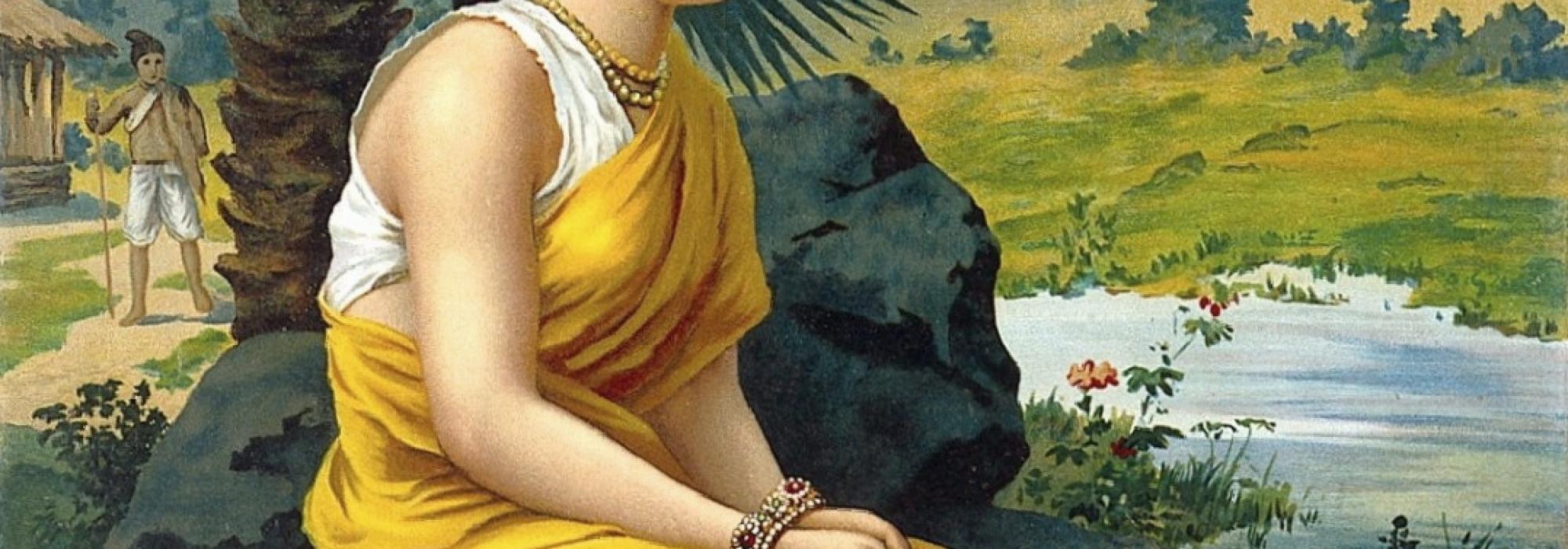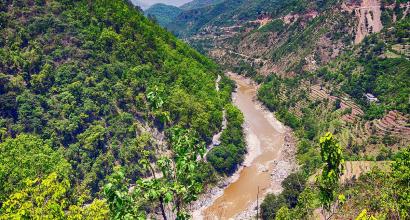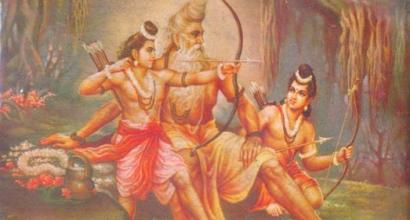Upon hearing the words of the sage, Rāma said, “There is no match for Hanūmān’s valour, commitment, sincerity, and strength. He found Jānakī in Laṅkā, reduced the city to ashes, and killed innumerable rākṣasas in the battle that broke out thereafter. If not for him, I could have never recovered Sītā and vanquished Rāvaṇa. When the hostility broke out between Vālī and Sugrīva, why didn’t Hanūmān merely burn up Vālī? Tell me everything about this great vānara!”
The seer replied, “Yes, what you say of Hanūmān is true, O Rāghava! On Mount Sumeru lived Kesarī and Añjanā, the parents of Hanūmān. Vāyu begot Āñjaneya through Añjanā. One day, when his mother was away to fetch fruits, the little child Hanūmān was hungry and cried out loud. He heard no response from his mother but spotted the rising sun, which appeared like a cluster of red hibiscus flowers to him. Longing for fruit, he leapt up toward the rising sun in order to seize it. Vāyu protected him from the heat of the sun. At the same time, Rāhu was coming toward the sun to seize him and cause an eclipse. But, Hanūmān mauled him and a terrified Rāhu fled to Indra’s court. He complained to Indra that his source of food – the sun – was being seized by someone else. Indra, who was greatly agitated, mounted his Airāvata and proceeded to the place where Hanūmān and Sūrya were. Looking at Airāvata, Hanūmān thought it was a huge fruit and rushed towards the king of the elephants. Indra struck him with his vajrāyudha and he fell on a mountain. As he fell, his jaw (hanu) on the left side was fractured. Looking at his son injured, Vāyu blocked up all beings, closing their organs of excretion. Because of Vāyu’s wrath, all beings were deprived of breath and rushed to Prajāpati- Brahmā seeking relief. Brahmā, along with the innumerable devas and other beings, went to the place where Vāyu sat with his wounded son. With a touch of his hand, Brahmā revived Āñjaneya. Indra declared that the vānara would be known as Hanūmān (‘He who has a powerful jaw’) and blessed him with invulnerability from vajrāyudha. Similarly, the other devas blessed him with invincibility from different kinds of weapons.
Proud of his invincibility, Hanūmān went on a rampage in the āśramas of the seers and disrupted their rituals. Enraged, the sages belonging to the lineage of Bhṛgu and Aṅgirasa pronounced a curse upon him, “You shall, for a very long time, be unaware of your strength, relying on which you have been annoying us!” Thus forced to forget his might, Hanūmān roamed around āśramas without harming anyone. Because of the curse, Hanūmān did not realize his own strength when the fight broke out between Vālī and Sugrīva. He also passionately mastered vyākaraṇa – grammar.”
Thus, Rāma heard the deeds of the rākṣasas and the vānaras. He sent back the kings who had come from various corners of his empire to greet him and congratulate him. Rāma offered expensive gifts to Sugrīva and Vibhīṣaṇa and advised them to rule their kingdoms in strict adherence to dharma. The rākṣasas and vānaras left for their kingdoms. The puṣpaka-vimāna, which he had returned to Kubera, returned to Rāma and promised to be at his service whenever he wished.
~
Under Rāma’s able rule, dharma prevailed over the kingdom and there was prosperity all over. Rāma discharged his duties towards the kingdom in the mornings and spent the rest of the day in the antaḥpura. Sītā performed pūjā to the divinities in the mornings, prostrated before her mothers-in-law, and spent the rest of the day in Rāma’s company, decked in beautiful clothes and ornaments. The two spent happy moments in the aśoka-vana in Ayodhyā, drank the sweet maireya wine, and enjoyed watching performances of music and dance.
One day, Rāma observed an auspicious glow on Sītā’s face and experienced unparalleled delight. He said, “You are carrying a child! Wonderful! Tell me, what desire of yours must be fulfilled?” With a gentle smile, Vaidehī said, “I would like to spend time at the feet of the great ṛṣis in their tapovanas on the banks of the river Gaṅgā.” Rāma immediately said, “So be it! You will go there tomorrow, have no doubts!” With these words, he went into another chamber of his palace.
He sat amidst his aides who were amusing conversationalists, who jokingly told Rāghava many different stories. During one story, he asked one of his men named Bhadra, “What are people talking about in the city and provinces, Bhadra? What do the people in the city and the countryside say about me? What do they think about Sītā, Bharata, Lakṣmaṇa, and Śatrughna? It is but natural that at the beginning of a new reign, the royalty will be the subject of people’s conversations.”
Bhadra, with his palms joined in reverence, said, “The comments of the citizens are consistently favourable, O king! People hail your victory over Rāvaṇa. However, in the crossroads, markets, highways, gardens, and woodlands they are also heard saying, ‘Rāma slew the unassailable Rāvaṇa and brought the vānaras and rākṣasas under his sway. But, what sort of pleasure does he enjoy now in the company of Sītā, who was in Rāvaṇa’s clutches in the past? She was pressed to his flanks and was put in the aśoka-vana under the control of the rākṣasas. How does Rāma not despise her? We will have to put up with this from our own wives as well. People always follow what the king does.’ People in all towns and villages are saying so.”
Rāma was deeply pained upon hearing these words and asked his friends, “Is this true? Tell me?” They all saluted him and with their heads bowed to the ground, they replied, “This is how it is, there is no doubt.” Listening to the words they had all spoken, he dismissed them.
Rāma immediately called for his brothers Bharata, Lakṣmaṇa, and Śatrughna. His mind distressed, his head sunk low, and his mouth gone dry, he spoke to them thus, “You there are my life breath and are extremely wise men. You must hear the sort of talk that is heard among the people of the kingdom regarding Sītā and me. People severely criticise me and are disgusted with me. They wonder how I could have brought back a sinful Sītā with me. You have witnessed, O Saumitri, how the devas Agni, Vāyu, Sūrya, and Candra declared Maithilī to be innocent. She was handed over to me by Indra and in my heart – in my antarātmā – I knew very well that the illustrious Sītā was pure. Thus, I returned to Ayodhyā with Vaidehī. But now, there is a grave allegation against me and I am in pain. As long as gossip is repeated causing infamy to a person, he will fall into the lowest of the worlds. Infamy is condemned by the devas and good fame is honoured by them. All activities are performed for kīrti – fame. Moreover, scared of the allegations against me, I will end my life and abandon you all. What to say of the daughter of Janaka? I cannot imagine any agony greater than this. Saumitri, tomorrow morning, you must prepare a chariot driven by Sumantra, and escort Sītā to the border of the realm. Abandon her there. On the far side of the river Gaṅgā lies the āśrama of Sage Vālmīki and is situated on the banks of the river Tamasā. Once you leave her there, come back quickly. You must obey my instructions, Saumitri! Also, I should never be contradicted in any way with respect to Sītā. For, if I am to be opposed, it will give me extreme displeasure. You should all take an oath and not attempt to speak in the midst of my words in order to conciliate me. If you are obedient to my words, you must respect me. This very day Sītā must be taken away from here. She had expressed her wish to see the great āśramas on the banks of Gaṅgā.” Rāma spoke these words with his eyes filled with tears.
Lakṣmaṇa got a chariot ready. He said to Sītā, “On the orders of our king, O devi, I am to quickly drop you off at the lovely āśramas of munis on the banks of Gaṅgā.” Sītā was supremely thrilled upon hearing this. She gathered expensive ornaments and other precious objects in order to gift them to the sages’ wives. She mounted the chariot but immediately observed bad omens. She prayed for the well-being of her husband, mothers-in-law, and all the beings. Though Lakṣmaṇa knew the real state of affairs, he merely said, “Śivam! All is well!” They halted in the night in an āśrama on the banks of the river Gomatī and the next morning headed towards Gaṅgā. Upon looking at the river Gaṅgā in the distance, Lakṣmaṇa grew deeply despondent and wept loudly. Sītā was surprised and asked, “Why are you crying? I am extremely happy that we have reached the river Jānhavī, but you seem to be sad. Are you sorrowful for being separated from your beloved brother Rāma for two nights? Rāma is as dear to me as my own life, but I am not grieving this way. Please don’t be so childish. Take me across the river Gaṅgā and help me see the ascetics there! Once we have saluted them, we will spend a night there and return to the city.”
Lakṣmaṇa, upon hearing her words, wiped his eyes and got a lovely boat ready. He asked Sumantra to wait on the other bank of the river. As Lakṣmaṇa and Sītā reached the farther bank, Lakṣmaṇa spoke, joining his palms in reverence and his voice choking with tears, “Vaidehi, it feels as though an arrow has pierced my heart, in that, my brother has made me an object of censure for the world. I would have happily died instead of doing this task. Forgive me please and don’t be angry with me,” he said and fell to the ground. Sītā was alarmed looking at his behaviour and asked him the reason for his anguish. His face downcast, Lakṣmaṇa said, “O daughter of Janaka! In the royal assembly, Rāma heard about the vile rumours connected with you, that are spreading around the city and the villages. I cannot even imagine telling you all that, devi. Though you have been proved to be pure right in front of my eyes, the king has abandoned you who is scared of being criticised by people. Please don’t understand it in any other way, devi! So, in adherence to the king’s command as well as your desire, I have been asked to abandon you on the outskirts of a tapovana. Here, on the banks of the river Jāhnavī are the beautiful āśramas of the brahmarṣis. Vālmīki was the greatest friend of my father, Daśaratha. You may take shelter at his feet and dwell in his āśrama, with your heart devoted to your husband.”
Vaidehī collapsed upon hearing this and went unconscious for a while. Regaining consciousness, with her eyes full of tears, she said, “Lakṣmaṇa, this body of mine has been created only for suffering. What pāpa have I committed in the past, or whom did I separate from his wife, that I, a pativratā have been abandoned by the king! I followed Rāma’s footsteps and endured all hardships in the past. Tell, o dear one, how should I live forever in an āśrama cut off from everyone? And what explanation should I provide to the sages when they ask me how I have wronged the king to be abandoned by him? And Saumitri! I will in no way give up my life today by drowning in Jāhnavī, as I am carrying the future of my husband’s kingdom in my womb. Leave me, I am born to misery. Listen to my words, Lakṣmaṇa. You must bow down affectionately at the feet of my mothers-in-law with your palms joined in reverence and then inquire about the well-being of the king. You must tell him, ‘Act towards your people just as you do towards your brothers. I do not grieve for my own self, but act towards your people in such a way that you avoid their criticism.’”
As Sītā was speaking thus, Lakṣmaṇa hung his head low, unable to utter anything. He went in a pradakṣiṇa around her, boarded the boat, and weeping loudly, urged the boatman to row the boat. He reached the northern bank of the river and quickly mounted the carriage, under the burden of grief. He set forth looking again and again at Sītā, whose body was compressed like a woman without a protector. She too kept looking at Lakṣmaṇa as he left the place. Finding no one who could protect her, she wept loudly in the woods, which resounded with the cries of peacocks.
~
Hearing her cries, the sons of the sages rushed to Vālmīki and informed him about the sound of her wailing. They said, “We have never seen such a woman before, Bhagavan! She seems to be Śrī herself; she must be a goddess or the wife of a great man. We must give her an appropriate welcome.” Vālmīki saw the reality with the special vision he had acquired due to tapas. He hastened to the place where Maithilī was, carrying arghya for her in his hands. He spoke gentle words to her, “Dear child, you are Daśaratha’s daughter-in-law, Rāma’s wife and Janaka’s daughter. I know through the vision that I have acquired through my tapas that you are of pure character, O pativratā! I know the reason behind you being here now. There are tāpasīs living not far from my āśrama, O dear child. They will take care of you like their own daughter. You shall dwell in my āśrama, free of anxiety. You must be no more worried than if you were returning to your own house!”
With these words, Vālmīki escorted Sītā to the place where the tāpasīs were and put her in their care.
To be continued...
[The critically constituted text and the critical edition published by the Oriental Institute, Vadodara is the primary source. In addition, the Kannada rendering of the epic by Mahāmahopādhyāya Sri. N. Ranganatha Sharma and the English translation by Sri. N. Raghunathan have been referred.]











































